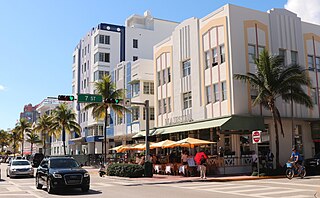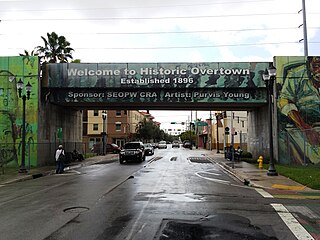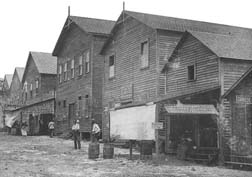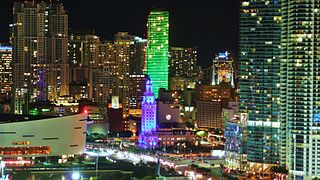
Gentrification is the process of changing the character of a neighborhood through the influx of more affluent residents and businesses. It is a common and controversial topic in urban politics and planning. Gentrification often increases the economic value of a neighborhood, but the resulting demographic displacement may itself become a major social issue. Gentrification often sees a shift in a neighborhood's racial or ethnic composition and average household income as housing and businesses become more expensive and resources that had not been previously accessible are extended and improved.

Miami, officially the City of Miami, is a coastal metropolis and the seat of Miami-Dade County in South Florida, United States of America. With a population of 442,241 as of the 2020 census, it is the second-most populous city in the state of Florida after Jacksonville. It is the core of the much larger Miami metropolitan area, which, with a population of 6.14 million, is the third-largest metro in the Southeast and ninth-largest in the United States. The city has the third-largest skyline in the U.S. with over 300 high-rises, 58 of which exceed 491 ft (150 m).

Coconut Creek is a city in Broward County, Florida, United States. Situated 37 miles (60 km) north of Miami, it had a population of 57,833 in 2020. It is part of the Miami-Fort Lauderdale-West Palm Beach, FL Metropolitan Statistical Area. The city seceded from Pompano Beach in the 1960s. It is nicknamed "Butterfly Capital of the World" because it is home to Butterfly World, the world's largest butterfly aviary, with over 80 species and 20,000 individual butterflies.

Coconut Grove, also known colloquially as The Grove, is the oldest continuously inhabited neighborhood of Miami in Miami-Dade County, Florida. The neighborhood is roughly bound by North Prospect Drive to the south, LeJeune Road to the west, South Dixie Highway and Rickenbacker Causeway to the north, and Biscayne Bay to the east. It is south of the neighborhoods of Brickell and The Roads and east of Coral Gables. The neighborhood's name has been sometimes spelled "Cocoanut Grove" but the definitive spelling "Coconut Grove" was established when the city was incorporated in 1919.

Little Haiti, is a neighborhood of Miami, Florida, United States. It is known historically as Lemon City, Little River and Edison. It is home to Haitian immigrant residents, as well as residents from the rest of the Caribbean.

Liberty City is a neighborhood in Miami, Florida, United States. The area is roughly bound by NW 79th Street to the north, NW 27th Avenue to the west, the Airport Expressway to the South, and Interstate 95 to the east. The neighborhood is home to one of the largest concentrations of African Americans in South Florida, as of the 2000 census. Although it was often known as "Model City" both historically and by the City of Miami government, residents more commonly call it Liberty City.
Bahamian Americans are an ethnic group of Caribbean Americans of Bahamian ancestry. There are an estimated 56,797 people of Bahamian ancestry living in the US as of 2019.

Overtown is a neighborhood of Miami, Florida, United States, just northwest of Downtown Miami. Originally called Colored Town in the Jim Crow era of the late 19th through the mid-20th century, the area was once the preeminent and is the historic center for commerce in the black community in Miami and South Florida.

Thousands of years before Europeans arrived, a large portion of south east Florida, including the area where Miami, Florida exists today, was inhabited by Tequestas. The Tequesta Native American tribe, at the time of first European contact, occupied an area along the southeastern Atlantic coast of Florida. They had infrequent contact with Europeans and had largely migrated by the middle of the 18th century. Miami is named after the Mayaimi, a Native American tribe that lived around Lake Okeechobee until the 17th or 18th century.

Liberty Square is a 753-unit Miami-Dade public housing apartment complex in the Liberty City neighborhood of Miami, Florida. It is bordered at Martin Luther King Jr. Boulevard/North 62nd Street to the south, North 67th Street to the north, State Road 933 to the east, and Northwest 15th Avenue to the west. Constructed as a part of the New Deal by the Public Works Administration and opening in 1937, it was the first public housing project for African Americans in the Southern United States.

Downtown Miami is the urban city center of Miami, Florida. The city's greater downtown region consists of the Central Business District, Brickell, the Historic District, Government Center, the Arts & Entertainment District, and Park West. It is divided by the Miami River and is bordered by Midtown Miami's Edgewater and Wynwood sections to its north, Biscayne Bay to its east, the Health District and Overtown to its west, and Coconut Grove to its south.

Wynwood is a neighborhood in Miami, Florida. Wynwood is known for being an entertainment district, with artwork, restaurants, breweries, clothing stores, and dance venues, among other retail options. Formerly an industrial district, the area is now known for the murals that cover the walls of many of the buildings and many of the sidewalks. It is north of Downtown Miami and Overtown, and adjacent to Edgewater. Wynwood has two major sub-districts, the Wynwood Art District in northern Wynwood, and the Wynwood Fashion District along West 5th Avenue. Wynwood roughly is divided by North 20th Street to the south, I-195 to the north, I-95 to the west and the Florida East Coast Railway to the east.

Haiti has a sizeable diaspora, present primarily in the United States, Dominican Republic, Cuba, Canada, France, the Bahamas, Brazil and Chile. They also live in other countries like Belgium, Turks and Caicos, Mexico, Puerto Rico, and the U.S. Virgin Islands, among others.

A conch house is a style of architecture that developed in Key West, Florida in the 19th century and used into the early 20th century. The style was also used in the other keys and in the Miami area. The introduction of the conch house style is attributed to immigrants from the Bahamas.

Peacock Park is a 9.4-acre (38,000 m2) public, urban park where Indian peacocks roam in the Coconut Grove neighborhood of Miami, Florida on the shore of Biscayne Bay.
The following is a timeline of the history of the city of Miami in Miami-Dade County, Florida, United States.
Gentrification, the process of altering the demographic composition of a neighborhood usually by decreasing the percentage of low-income minority residents and increasing the percentage of typically white, higher-income residents, has been an issue between the residents of minority neighborhoods in Chicago who believe the influx of new residents destabilizes their communities, and the gentrifiers who see it as a process that economically improves a neighborhood. Researchers have debated the significance of its effects on the neighborhoods and whether or not it leads to the displacement of residents. There are some researchers who claim that the loss of affordable housing mainly impacts the poorer minority residents and causes them to have to move out of their neighborhoods which destabilizes their cultural communities. However, critics say that since gentrification often excludes highly black neighborhoods, those residents are prevented from benefiting from any of the positive effects such as redevelopment and neighborhood investment. Factors associated with and used to measure gentrification in Chicago are changes in the number of residents with bachelor's degrees, median household income, racial composition, visual observations, and the presence of coffee shops. Historically, the emergence of urban black and Latino neighborhoods in Chicago during the 1950s through the 1970s were made possible because of the waves of white residents moving out into more suburban neighborhoods. There have been phases of gentrification in Chicago of various neighborhoods, some of which were in 1990s and in 2007–2009. Gentrification debates in Chicago have been mostly focused around the gentrification of Chicago's historically Latino or black neighborhoods. Generally, these neighborhoods are located near the central urban downtown areas and along the east side of the city.
Race riots in Miami include a series of violent events that occurred in Miami mainly through the 1980s. After desegregation, much of the racial violence in Miami had calmed only to be reignited by the 1980s. The decade of riots were the result of policing controversies and ethnic tensions fueled by the perceived threat of recent immigrants to African Americans on the Miami job market.

The gentrification of Baltimore, Maryland, began in 2000 and continues to transform the city by redeveloping specific neighborhoods to appeal to wealthier residents. Due to Baltimore's large amount of gentrification, the city accounts for a significant amount of the United States gentrification. The gentrification of Baltimore has occurred throughout the city, but particularly in the neighborhoods surrounding the Inner Harbor in Central Baltimore and East downtown Baltimore. The gentrification of Baltimore has occurred through the addition of new housing, increased commercial spaces, and more. The transformation that has occurred throughout the city of Baltimore has many benefits as it improves the city in various ways. However, many others feel that gentrification is unfavorable for Baltimore because it displaces current residents from their homes due to rising prices in newly gentrified neighborhoods.
Climate gentrification is a result of climate migration, changes in populations due to environmental changes caused by climate change, in which certain lower-socioeconomic communities are displaced place of housing for more wealthy communities. Areas affected by this phenomenon are typically coastal cities, islands, and other vulnerable areas that are susceptible to rising sea levels, extreme weather events, and other climate-related disasters.















